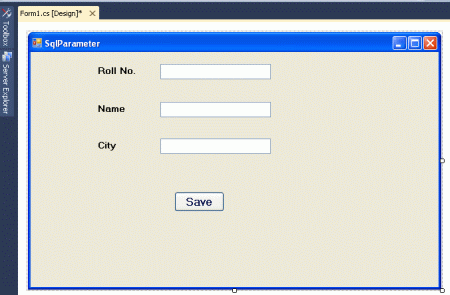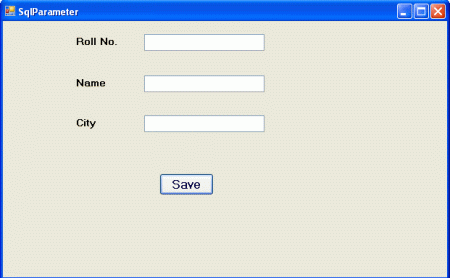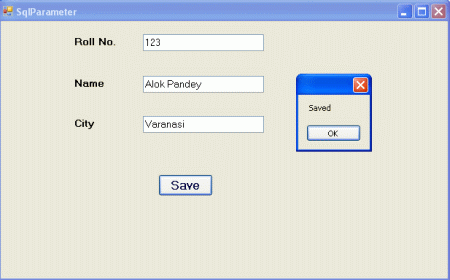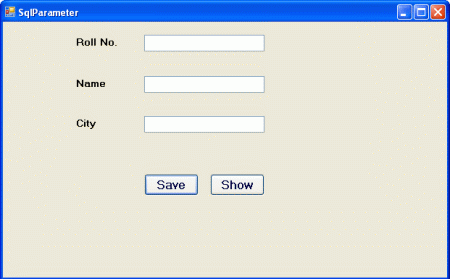Introduction
The SqlParameter class is found in the "System.Data.SqlClient" namespace. It is a class of a connected architecture of .NET framework. It represents parameters. To work with the SqlParameter class we should have a database. In this example I am using a Database "student" which has a "student_detail" table. "RollNo", "Name" and "City" are column names. I will save and retrieve records using SqlParameter class. Here is a list of important properties of the SqlParameter class which will be used in this example.
The SqlParameter class is found in the "System.Data.SqlClient" namespace. It is a class of a connected architecture of .NET framework. It represents parameters. To work with the SqlParameter class we should have a database. In this example I am using a Database "student" which has a "student_detail" table. "RollNo", "Name" and "City" are column names. I will save and retrieve records using SqlParameter class. Here is a list of important properties of the SqlParameter class which will be used in this example.
SqlDbType : It is used to set the Sql Server Data types for a given parameter.
ParameterName : It is used to specify a parameter name.
Direction : It is used for setting the direction of a SqlParameter. It is Input or Output or both (InputOutput).
Size : It is used to set maximum size of value of parameter.
Value : It is used for assigning or getting value of the parameter.
Now, take a Windows Forms application in Visual Studio 2010. Take some UI Controls and arrange them as shown in the figure below.

Write the following code for saving a record into the database.
using System;
using System.Collections.Generic;
using System.ComponentModel;
using System.Data;
using System.Drawing;
using System.Linq;
using System.Text;
using System.Windows.Forms;
using System.Data.SqlClient;
namespace WorkWithSqlParameterClass
{
public partial class Form1 : Form {
public Form1()
{
InitializeComponent();
}
SqlConnection conn;
SqlCommand comm;
string connstring = "database=student;server=.;user=sa;password=wintellect";
private void btnsave_Click(object sender, EventArgs e)
{
conn = new SqlConnection(connstring);
conn.Open();
comm = new SqlCommand();
comm.Connection = conn;
//Creating instance of SqlParameter SqlParameter PmtrRollNo = new SqlParameter();
PmtrRollNo.ParameterName = "@rn";// Defining Name PmtrRollNo.SqlDbType = SqlDbType.Int; // Defining DataType PmtrRollNo.Direction = ParameterDirection.Input; // Setting the direction
//Creating instance of SqlParameter SqlParameter PmtrName = new SqlParameter();
PmtrName.ParameterName = "@nm";// Defining Name PmtrName.SqlDbType = SqlDbType.VarChar; // Defining DataType PmtrName.Direction = ParameterDirection.Input;// Setting the direction
//Creating instance of SqlParameter SqlParameter PmtrCity = new SqlParameter();
PmtrCity.ParameterName = "@ct"; // Defining Name PmtrCity.SqlDbType = SqlDbType.VarChar; // Defining DataType PmtrCity.Direction = ParameterDirection.Input;// Setting the direction
// Adding Parameter instances to sqlcommand
comm.Parameters.Add(PmtrRollNo);
comm.Parameters.Add(PmtrName);
comm.Parameters.Add(PmtrCity);
// Setting values of Parameter
PmtrRollNo.Value = Convert.ToInt32(txtrollno.Text);
PmtrName.Value = txtname.Text;
PmtrCity.Value = txtcity.Text;
comm.CommandText = "insert into student_detail values(@rn,@nm,@ct)";
try {
comm.ExecuteNonQuery();
MessageBox.Show("Saved");
}
catch (Exception)
{
MessageBox.Show("Not Saved");
}
finally {
conn.Close();
}
}
}
}
Run the application.
Output

Fill in the form and click the "Save" button. The record will be saved to the Database and a message box will be displayed with a confirmation message.

Now we retrieve records from the database. Take another button and set its text property as "Show". Add the following code for the "Show" button.
Now, take a Windows Forms application in Visual Studio 2010. Take some UI Controls and arrange them as shown in the figure below.

Write the following code for saving a record into the database.
using System;
using System.Collections.Generic;
using System.ComponentModel;
using System.Data;
using System.Drawing;
using System.Linq;
using System.Text;
using System.Windows.Forms;
using System.Data.SqlClient;
namespace WorkWithSqlParameterClass
{
public partial class Form1 : Form {
public Form1()
{
InitializeComponent();
}
SqlConnection conn;
SqlCommand comm;
string connstring = "database=student;server=.;user=sa;password=wintellect";
private void btnsave_Click(object sender, EventArgs e)
{
conn = new SqlConnection(connstring);
conn.Open();
comm = new SqlCommand();
comm.Connection = conn;
//Creating instance of SqlParameter SqlParameter PmtrRollNo = new SqlParameter();
PmtrRollNo.ParameterName = "@rn";// Defining Name PmtrRollNo.SqlDbType = SqlDbType.Int; // Defining DataType PmtrRollNo.Direction = ParameterDirection.Input; // Setting the direction
//Creating instance of SqlParameter SqlParameter PmtrName = new SqlParameter();
PmtrName.ParameterName = "@nm";// Defining Name PmtrName.SqlDbType = SqlDbType.VarChar; // Defining DataType PmtrName.Direction = ParameterDirection.Input;// Setting the direction
//Creating instance of SqlParameter SqlParameter PmtrCity = new SqlParameter();
PmtrCity.ParameterName = "@ct"; // Defining Name PmtrCity.SqlDbType = SqlDbType.VarChar; // Defining DataType PmtrCity.Direction = ParameterDirection.Input;// Setting the direction
// Adding Parameter instances to sqlcommand
comm.Parameters.Add(PmtrRollNo);
comm.Parameters.Add(PmtrName);
comm.Parameters.Add(PmtrCity);
// Setting values of Parameter
PmtrRollNo.Value = Convert.ToInt32(txtrollno.Text);
PmtrName.Value = txtname.Text;
PmtrCity.Value = txtcity.Text;
comm.CommandText = "insert into student_detail values(@rn,@nm,@ct)";
try {
comm.ExecuteNonQuery();
MessageBox.Show("Saved");
}
catch (Exception)
{
MessageBox.Show("Not Saved");
}
finally {
conn.Close();
}
}
}
}
Run the application.
Output

Fill in the form and click the "Save" button. The record will be saved to the Database and a message box will be displayed with a confirmation message.

Now we retrieve records from the database. Take another button and set its text property as "Show". Add the following code for the "Show" button.
private void btnshow_Click(object sender, EventArgs e)
{
conn = new SqlConnection(connstring);
conn.Open();
comm = new SqlCommand();
comm.Connection = conn;
//Creating instance of SqlParameter SqlParameter PmtrRollNo = new SqlParameter();
PmtrRollNo.ParameterName = "@rn";// Defining Name PmtrRollNo.SqlDbType = SqlDbType.Int; // Defining DataType PmtrRollNo.Direction = ParameterDirection.Input; // Setting the direction
//Creating instance of SqlParameter SqlParameter PmtrName = new SqlParameter();
PmtrName.ParameterName = "@nm";// Defining Name PmtrName.SqlDbType = SqlDbType.VarChar; // Defining DataType PmtrName.Size = 30;
PmtrName.Direction = ParameterDirection.Output;// Setting the direction
//Creating instance of SqlParameter SqlParameter PmtrCity = new SqlParameter("@ct", SqlDbType.VarChar, 20);
PmtrCity.Direction = ParameterDirection.Output;// Setting the direction
// Adding Parameter instances to sqlcommand
comm.Parameters.Add(PmtrRollNo);
comm.Parameters.Add(PmtrName);
comm.Parameters.Add(PmtrCity);
// Setting values of Parameter
PmtrRollNo.Value = Convert.ToInt32(txtrollno.Text);
PmtrName.Value = txtname.Text;
PmtrCity.Value = txtcity.Text;
comm.CommandText = "select @nm=name,@ct=city from student_detail where rollno=@rn";
try {
comm.ExecuteNonQuery();
txtname.Text = PmtrName.Value.ToString();
txtcity.Text = PmtrCity.Value.ToString();
}
catch (Exception)
{
MessageBox.Show("Not Found");
}
finally {
conn.Close();
}
}
}
Run the application.
Output

Enter a roll number and click the "Show" button. It will show all the related information of the student having the given roll number.
{
conn = new SqlConnection(connstring);
conn.Open();
comm = new SqlCommand();
comm.Connection = conn;
//Creating instance of SqlParameter SqlParameter PmtrRollNo = new SqlParameter();
PmtrRollNo.ParameterName = "@rn";// Defining Name PmtrRollNo.SqlDbType = SqlDbType.Int; // Defining DataType PmtrRollNo.Direction = ParameterDirection.Input; // Setting the direction
//Creating instance of SqlParameter SqlParameter PmtrName = new SqlParameter();
PmtrName.ParameterName = "@nm";// Defining Name PmtrName.SqlDbType = SqlDbType.VarChar; // Defining DataType PmtrName.Size = 30;
PmtrName.Direction = ParameterDirection.Output;// Setting the direction
//Creating instance of SqlParameter SqlParameter PmtrCity = new SqlParameter("@ct", SqlDbType.VarChar, 20);
PmtrCity.Direction = ParameterDirection.Output;// Setting the direction
// Adding Parameter instances to sqlcommand
comm.Parameters.Add(PmtrRollNo);
comm.Parameters.Add(PmtrName);
comm.Parameters.Add(PmtrCity);
// Setting values of Parameter
PmtrRollNo.Value = Convert.ToInt32(txtrollno.Text);
PmtrName.Value = txtname.Text;
PmtrCity.Value = txtcity.Text;
comm.CommandText = "select @nm=name,@ct=city from student_detail where rollno=@rn";
try {
comm.ExecuteNonQuery();
txtname.Text = PmtrName.Value.ToString();
txtcity.Text = PmtrCity.Value.ToString();
}
catch (Exception)
{
MessageBox.Show("Not Found");
}
finally {
conn.Close();
}
}
}
Run the application.
Output

Enter a roll number and click the "Show" button. It will show all the related information of the student having the given roll number.
No comments:
Post a Comment